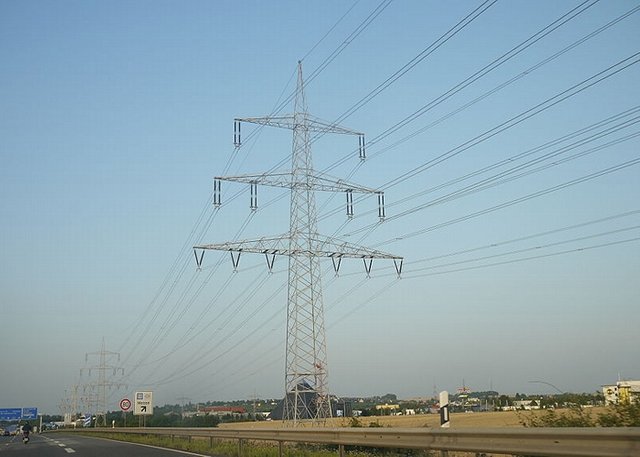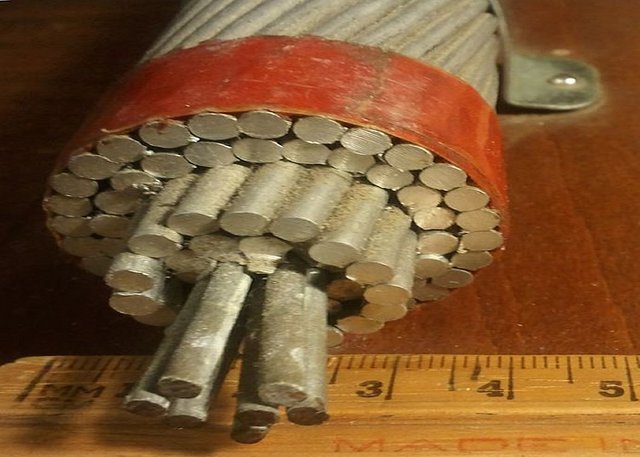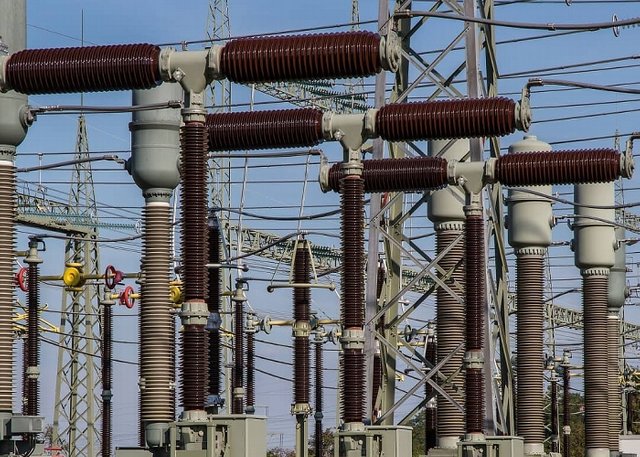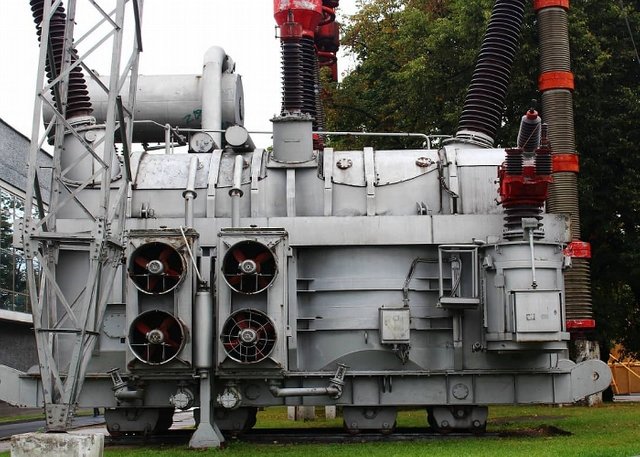Electricity Transformers: Understanding How High Voltage Electricity Are Relayed And Made Compatible For Domestic and Factory Uses
Irrespective of where you live or the country you come from, I am sure you must have seen those giant power lines that run unendingly from one end of the country to another, carrying electricity from power plants to homes at very high voltages as much as 400,000 to 750000 volts. But we know that home appliances do not need such high volts of electricity to work. Depending on the country and the device, home appliances need between 110 to 250 volts to work which is thousands of times smaller than the amounts being supplied from power plants.

[Electric power transmission. Source: Wikimedia commons. Author: 123df. CC BY-SA 3.0 licensed]
As clear as it is, it is unthinkable and, in fact, a suicidal mission to try to power any home appliance from such a huge electricity pylon. So, since it is impossible to power a home appliance directly from this huge source of electricity, then there has to be a way to bring the high voltage electricity down to range compatible with home appliances. That electrical device with which this can be done is known as a transformer and concisely defined as...
...a device that changes (i.e. transforms) an alternating potential difference (voltage) from one value to another value be it smaller or greater using the principle of electromagnetic induction. | Source
In this article, therefore, we will be looking at how a typical transformer works, and the reasons for which electrical power generation and distribution companies transmit electrical power at high voltages when they are fully aware that home appliances only require between 110 to 250 volts of electricity. In other words, why can't they just transmit power at 110 — 250 volts?
Why electricity is transmitted at high Voltages by power companies
Like has been previously mentioned, one would not be wrong to question the decision of power companies to transmit electricity at high voltages knowing the range of voltage requirement in home appliances. Well, there are two major considerations why this is so. And we need to know how electricity travels through wires to understand the underlying reasons for this.
_line1.jpg)
[Sample high tension power line. Source: Wikimedia commons. Author: ClarkMills. CC BY-SA 3.0 licensed]
As electricity flows through metal wires, electrons that are carrying its electrical power collide with the metal atoms which offer resistance against free flow of electricity. The friction resulting from the interaction of electrical-power carrying electrons and the resistance of metallic atoms generates energy which is lost to environment as heat energy. This explains why wires gets hot when electricity is passed through them. It has been established that the fraction of energy lost to resistance is considerably reduced when electricity is transmitted at high voltage and low currentref. Hence, the higher the voltage, the lower the current and because current is low, the resistance of metallic conductor will also be low and so less energy is lostref.
That being said, another reason electricity is transmitted at high voltage is variations in voltage needs of the consumers. Since the energy a device uses is proportional to the voltage it uses, energy needs of giant machines in factories may not be the same with energy needs of domestic appliances. Some industrial machines are energy-hungry and may need to be powered with voltages that are way above that needed to power home appliances. For instance, between 110 to 250volts is mostly the range of voltage requirement for home appliances, factory machines may require as much as 10000 — 30000 volts to function. It makes sense, therefore, to transmit electricity at voltage that is well above the individual voltage needs of different consumers. When such high-voltage electricity gets to its destination, it can then be stepped down and distributed to different consumers in accordance with the voltage needs of their appliances.
How electricity transformers work
Generally, transformers, irrespective of their sizes, work on the same principle which is based on some interesting behaviors of a constantly fluctuating electricity. Ideally, a fluctuating electric current that's flowing through a wire will generate a magnetic flux around the wire. The strength of this magnetic flux was observed to be proportional to the size of the electric current generating it. So if we want to increase the strength of the magnetic field, we simply increase the size of the current passing through the wire. Conversely, when a magnetic field fluctuates around a piece of wire, it creates electric current in the wire.

[Source: Pixabay commons licensed]
Now, if we take two coils of wire and place them close but not in contact with each other, and pass a fluctuating electric current into one of the coils, electric current will be generated in the second coil even without the two wires actually touching. We call the electric current in the first wire coil primary current and the one where the current was transferred, secondary current. It can be seen here that we were able to transmit electric current across an empty space between two coils of wire. This is called electromagnetic induction as there is no contact between the two coils of wire, yet electric current in the first coil was able to "induce" electric current in the second coil. The efficiency of electric current transfer between the two coils of wire can be enhanced by winding them around a soft iron bar known as a core.
Coils of wire are simply made by curling a piece of wire into a loop known as turns, which is a central factor in determining the size of the output current and voltage for a given transformer. For instance, if the number of turns of the second coil is the same as the first coil, the amount of primary and secondary current and voltage will be the same in both wire coils. When there are more number of turns in the second coil than there are in the first coil, greater voltage and electric current will be produced in the second coil. In this case, we refer to the transformer as a step-up transformer.

[Source: pixabay commons. CC0 licensed]
Conversely, when there are fewer number of turns in the second coil relative to the first coil, less electric current and voltage is created in the second coil. And we say the transformer is a step-down transformer. High-voltage electricity from power companies needs to be stepped down for it to be compatible with our home appliances and industrial For all that has been described here to work seamlessly, an Alternating current (AC) must be used as transformers don't work with Direct current DC. For more details on AC/DC currents, you can read AC/DC affairs by @greenrun.
Conclusively, as I did say at some point in this article. All transformers work on the same principle and are made of core iron bar, primary and secondary windings. Transformers come in different sizes; the range of voltage requirements of different appliances is an important factor in designing the capacity and type of transformers that are suitable for them. Whereas TV, electric Irons and refrigerators may require voltages in the range 110 — 250 volts. Smaller appliances like cellphones, chargers, laptops, etc may require voltages which are significantly less. These electronic appliances have small transformers that are built into them to carry out conversion of 110 — 250 volts in accordance with the device specific voltage requirement. Thanks for reading.
References for further reading
- Transformer
- Transmitting electricity at high Voltages
- Alternating current transformers
- Electricity transformers
- Transformer
- Principle of Transformers
- Electric power transmission
Yours truly,
@eurogee
Do You Blog About Science, Technology, Engineering, and Mathematics? If Yes, Patiently Read The Below Info


Join Euronation Community on Telegram and whatsapp through the below links to socialize with larger steemit community:

No Witnesses = No Steem Blockchain; If You Truly Love Here, Vote For Witnesses NOW!
Click This Link To Vote Now


I think this is an excellent subject! very important as is the saving of our electrical energy and the good distribution of its consumption!
Have no idea what you're talking about. Obviously, you didn't read this post
Interesting article!
I wonder how the distribution of electricity will change in the future!
at This moment all I can say is I have phobia to electric tower.
Thank you @eurogee this was very educative and i have a small question
Does this mean that stabilizers are equipped with both step up and step down transformers?
Yes, some.
This post has been voted on by the steemstem curation team and voting trail.
There is more to SteemSTEM than just writing posts, check here for some more tips on being a community member. You can also join our discord here to get to know the rest of the community!
Nice one @eurogee though contrary to what you said, most developed countries don't fly power cables like we do here in Nigerian. Nicely crafted out post.
Only in the city. In their countrysides, they do bro.
Hi @eurogee!
Your post was upvoted by utopian.io in cooperation with steemstem - supporting knowledge, innovation and technological advancement on the Steem Blockchain.
Contribute to Open Source with utopian.io
Learn how to contribute on our website and join the new open source economy.
Want to chat? Join the Utopian Community on Discord https://discord.gg/h52nFrV
That was an awesome presentation. Thank you for sharing.
Welcome @greenrun sir!
Congratulations @eurogee! You have completed the following achievement on Steemit and have been rewarded with new badge(s) :
Click on the badge to view your Board of Honor.
If you no longer want to receive notifications, reply to this comment with the word
STOPTo support your work, I also upvoted your post!
Do not miss the last post from @steemitboard:
SteemitBoard World Cup Contest - The results, the winners and the prizes